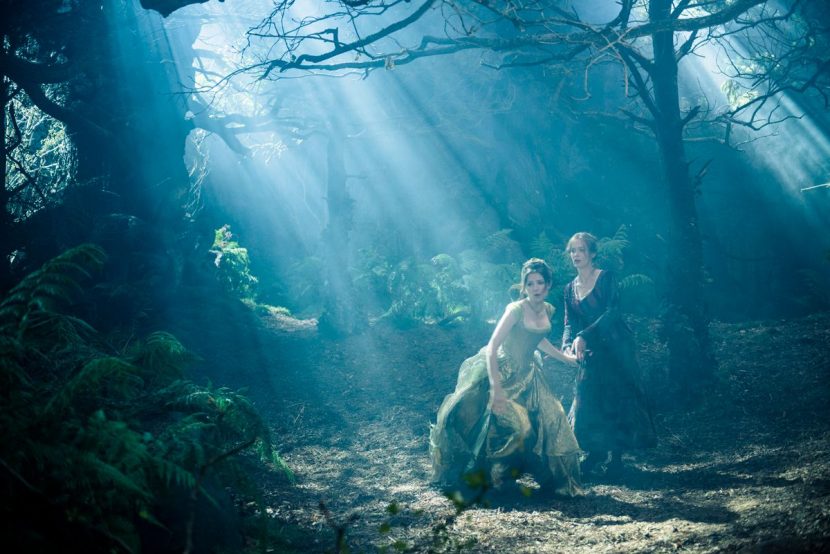Rob Marshall’s Into the Woods is the cinematic version of the famous Stephen Sondheim musical, combing various fairytale elements into one story. Although these elements were fantastical in nature, the director sought out a more practical approach to filming and realization. We speak to overall visual effects supervisor Matt Johnson about his effects solutions, from beanstalks, to miniature forests, giants, transforming dresses and drone shoots.
Watch a sizzle reel for Into the Woods.
fxg: This film in some ways was more of an invisible effects type film despite the sort of fantastical nature of it. Can you tell me a bit about that approach to the film’s effects?
Matt Johnson: Well, Rob Marshall had a very, very clear idea of what he wanted everything to look like, from costume, wardrobe, hair, lighting, through to obviously the visual effects. So, a part of that slightly muted style – and he definitely didn’t want the film to appear magical in the classic sort of, I don’t know, Hollywood style. So, any elements of pixie dust or any of the normal magic effects that have been through the movies before, he definitely didn’t want to do that. He wanted everything to feel more organic, to feel more natural, and yeah, it’s a darker sort of fairy tale. It’s not a – it’s more to the tune of the Brothers Grim rather than, I don’t know, Walt Disney.
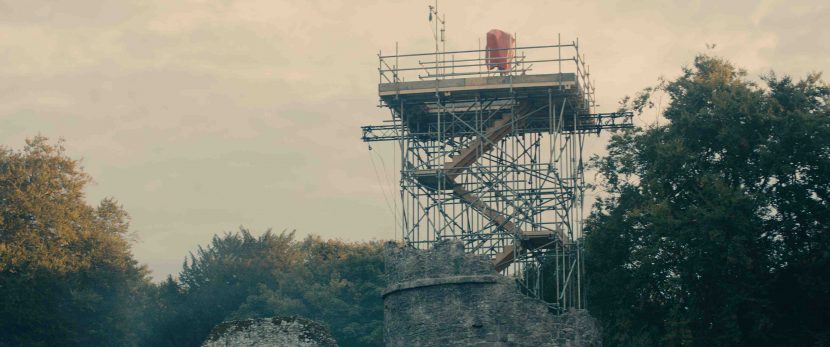
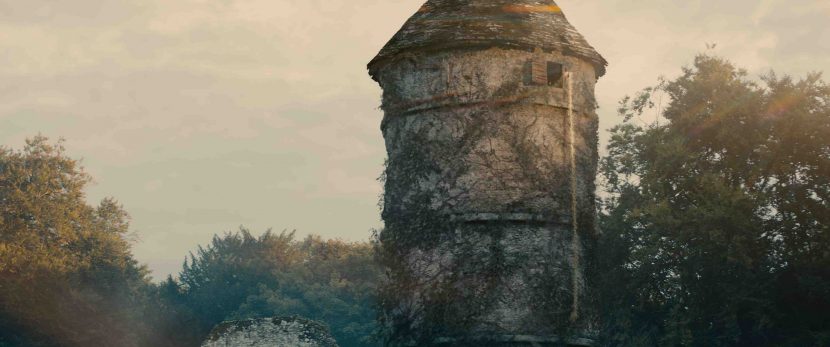
fxg: Where it was filmed and what were some of the environment challenges?
Matt Johnson: Principal production was primarily in the UK. And the way the film sort of works, it splits down into two sort of distinct acts; the first act being kind of happier and the second act being a little darker. The first half of the movie was largely shot outside on location, and that would range from locations like Dover Castle and Windsor Great Park for the forests, through to Waverley Abbey, to the places that are kind of outside, that obviously Dennis Gassner, who is the production designer – sort of, I guess, a multi-Academy Award-winning production designer – would kind of go in and put his take on everything.
That was largely based on real places that then digitally we would enhance. Obviously, if it’s Rapunzel’s tower, they built a little bit of the bottom section of the tower and the rest of it would be something that we would add later. If there’s a castle, we shot a bit of a castle, but then we would change the structure a little bit, added in towers and turrets, and making some things fall down. So that was the first half of the film primarily. It’s a slightly more real – there’s Hambledon Village, which is kind of – I think it has been used in everything since Chitty-Chitty-Bang-Bang, I think, as a kind of classic look to the village. Where Jack and his grandmother live is a barn, which we actually found on our first director scout – we were wandering around and actually saw this barn, wandered down to have a look, and it’s like, “Wow, this is absolutely perfect.” So, that’s what we used there. So, the real structure existed, then obviously we added the beanstalk and the various other bits and pieces.
Watch behind the scenes.
The second half is after the collapse of the tower collapses and when they realize that there’s a second giant sort of loose. Then, we are in a lot more of the woods, because obviously the movie is about being in the woods and what that means on both a literal sense and also on a kind of the subtext about what’s it’s like to be kind of lost and separated from what you know and are comfortable and familiar with.
So, that was then on H stage, which is actually one of the largest stages in the UK. Basically, we built a forest, where we had horses galloping through it, we had large musical numbers staged, we had banks, we had all sorts of things like that going on, and then we just – yeah, we enhanced that. We would, for example, if we’re shooting off the top of the set, we would add in stuff, we would paint out lights, we would just kind of help it a little bit, but again, very much stylistically trying to keep it within the kind of a color palate established by the filmmakers.
fxg: You mentioned the giants, so what was the approach there – they seemed more live action than CG?
Matt Johnson: Again, we wanted to go old-school, which is actually, for me, something I’ve always been involved and interested in. So, this definitely wasn’t the movie for a big CG giant; that’s not something that any of us would sort of ascribe to from the very first meetings. It’s just not that film.
So, we built – on W stage, we had the miniature effects guy, Jose Granell who built Hogwarts for Harry Potter and various other things. I got him involved, and I got him to build me a miniature forest on W stage, and then we had trees, and little landscapes, and banks, and little miniature leaves, and all that kind of stuff built, and we fogged the set up. We had big smoke machines and they would give it atmosphere, and aerial haze, and aerial perspective.
And then we got our actors and doubles to kind of walk through this miniature environment and to knock the trees down and to smash them over, and basically to play the scene. So again, for Rob, he could have a real performer there, Frances de la Tour. He could direct her and get her to do what he wanted and we over-cranked – we did it like a good old-fashioned visual effects movie. We shot it 64 frames per second, I think, which was our sort of preferred frame rate of choice.
Then digitally, we then – keeping it slightly more up to date – we would go in and add tiny little CG leaves falling, so if she brushed into something, then we would have little digital leaves kind of falling away from things. What I wanted to do was always have something real in the foreground; so for the background, we would then get some real tree foreground elements, and then add them later in the post.
I wanted to kind of fuse real elements, miniature elements, and subtle bits of CG. So, we did things like the birds flying and had the shadows coming off the birds, and we had – it was a nice kind of combination. But very much wanting to get an old-fashioned style, something that the audience are familiar with, and not to take you out of the movie by suddenly having the big flashy animated creature, because it’s clearly not that film, and stylistically would have been very jarring.
fxg: Tell me about effects for The Witch’s entrance and exits?
Matt Johnson: Again, it was trying to come up with a way that Meryl could appear that was magical, but of the place that she comes from. So, for example, the first time she disappears, she’s in a baker’s shop. So, I came up with this sort of the fast exit idea which sort of became the basis of all those effects. But it would always reflect the environment that she’s in. So, the first time she disappears, she’s at the baker’s shop, so there’s flour and stuff sort of predominantly, which gives it kind of a nice smoky sort of look as everything kind of toils and swells around her.
And then there’s another time that she’s in the forest, so it’s predominantly leaves. So again, it’s all of the environment that she’s in. I mean, there’s some little core magical stuff that is quite subtle. But we’re basically taking the environment that the scene takes place in and then using elements of that to make – to kind of ground it in the environment that it’s taking place in. Basically, that’s how we do that – it’s a particle scene, with different objects running through it, whether it be, you know, the flour or leaves.
fxg: How did you approach Cinderella’s dress transformation?
Matt Johnson: That was a fun one. That was interesting, because that was shot as – it was actually probably one of the more complicated shots, with a motion control setup. So what we did for that – we had a blue-screen stage and we had a large motion control rig, and I worked a lot with Anna Kendrick, who’s fantastic. I mean, the way she can kind of remember the move that she did – so, we got her on the bluescreen set, with the remote control camera going up and over the top of her to recreate this kind of dance movement that she did.
Obviously, we had to play back her music and stuff, and she had to remember that her hand needs to be trailing at this point, so we got the performances lined up as tight as we could. So, we got her to do that in her two different outfits, which was great fun. As I said, she was extremely pleasant to work with, for what was an extraordinarily complicated system.
So, we did that on a bluescreen, and then took that same motion control camera – took it physically onto the set, and then repeated that move, so we would then have a live action background plate, and that lined up remarkably well, as her feet were grounded on the floor. So, we took that. And then as a final kind of level, we added additional CG to the willow, ferns, and branches, so as the camera goes up and over, it’s actually moving through a CG tree environment as well, just to give some more depth and levels within the frame.
Then again, we – Rob and I didn’t want a very magical effect, as it needed to be quite subtle. It’s one of those things, you probably have to watch it a few times to really get a sense of what it was. It’s supposed to just happen. So, we did a very subtle kind of wipe – it’s what we used earlier when her mother appears in the tree, where as you’ve seen, it’s different animated wipes running smoke elements through the map. So, there’s a softer, more organic feel to it.
It’s not just an animated shape. There’s actually texture within that shape as it transforms. So, we did that. Then, obviously, again, we had a swirly vortex affect, based upon the willow leaves. And then, what we did is, as they got closer to the dress, we just made them pick up a little bit of light to give it a hint of gold, so they would again – the idea being that the dress was formed from the leaves from the tree, possibly. That’s part of the rationale behind it – the tree was her mother, and her mother was giving part of herself, to be the dress.
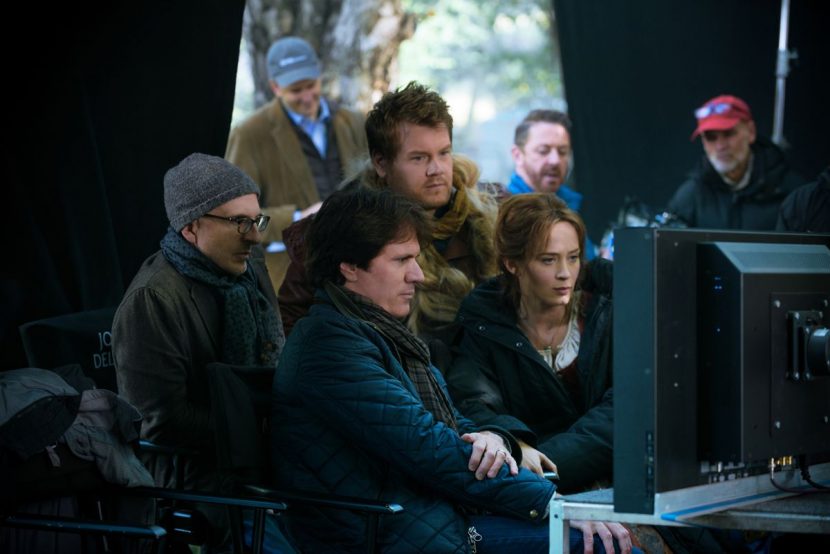
fxg: What about the beanstalk shots? Was there a general approach to it growing?
Matt Johnson: It was to give it a slightly, the growth – there have been a few beanstalk movies recently, and we wanted to make ours a little bit more – I guess we sort of wanted a bit more, I’m trying to think of the right word – there’s a better word than this, but I guess snake-like. And that’s sort of the way it kind of grows. There’s a little more organic kind of twisting and stuff coming out from it. Rob didn’t want like a hard sort of thrust-like, with thorns and all that kind of stuff, in the giant’s lair.
It needed to kind of have a little bit more of a more sort of natural, organic kind of way it went up and grew and twisted and things like that. It’s not just one beanstalk initially, it’s five beans that are thrown down, so it’s the way that these beans, the stalks, wrap and intertwine around each other to form the beanstalk that Jack climbs up. So, yeah, that’s basically as it comes out of the ground, and then we did it again – another particle scene for the ground shots. So there’s earth moving and ground cracking and things like that, which is all basically a dynamic scene, as the ground goes.
So, that’s for that first shot, when we go up, sort of pass Jack, look out the window and see everything growing. And then we cut wide to the digital beanstalk. We had a small ground piece at the location, and we essentially replaced that with a digital beanstalk for the shot where it comes out and first sees it. Then obviously we cut wide, to a large vista which is a matte painting visual projection, to give it parallax, and then added that beanstalk, just the beanstalk in the background, for the final reveal.
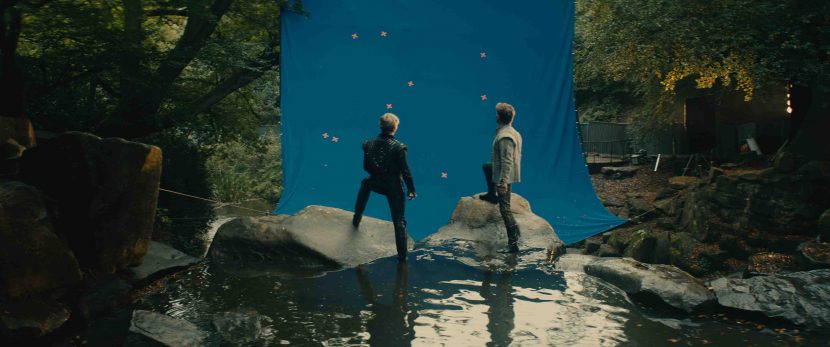
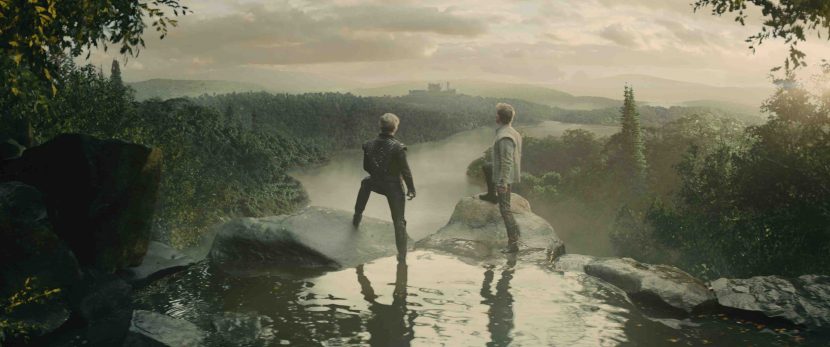
And a little flock of birds in there, just for the effects joke, they’re just in to be kind of be motivated by Tracey Ullman’s scream. I put those in just as a gag, and yeah, Rob seemed to like it. And then for the beanstalk that Jack’s climbing on, the actor was physically on a beanstalk set piece, but we ended up basically removing that entirely – the set piece entirely from the movie, and replacing it totally with a CG chunk. So he’s actually touching, interacting, holding, a fully CG beanstalk, which is basically covering up the full set piece that was there. Again, those shots have to have a style – again, they have a style that fits very much Rob Marshall, in terms of the way they look, the way the background is, and stuff like that.
fxg: When The Witch dies you had her rise up and fall back to the earth again – how did you do that?
Matt Johnson: That was quite an elaborate thing, to get that to work. We had to remodel and re-project Meryl onto geo to make her fall further down the hole than was practicable on set. In fact, there’s an awful lot – in that sequence generally, all the swirly smoke, the leaves, all that kind of stuff whipping past camera is all CG. So, it wasn’t really practical to kind of do that stuff on set with Meryl while she was performing. It’s very hard to sing a song with a wind machine and smoke blowing in your face. So there’s a lot of that sort of swirly atmospherics that was digitally added later.
fxg: How did you tackle the tower shots?
Matt Johnson: At Dover Castle, we’ve added in and we’ve changed the structure of the castle a little bit – there’s a tower that isn’t there. So, real and other things have been changed and tweaked a little bit, and the tower obviously collapses a little later, sort of about halfway through the movie again, as a nice sort of dynamics as it collapses and falls through into the ground. But there’s various shots where we just play with things just a little bit. Rapunzel’s tower, I think I’ve said, we’ve only ever built half of it for real, if that, and just extended the rest of it.
More behind the scenes.
fxg: Can you talk about the end shot of the film?
Matt Johnson: The big end shot of the movie, that starts with a very sort of slow lift up on a Technocrane on set. You knew the scene was going to be good, because when we’re – the people actually filming it, the grips operating the Technocrane were crying. So, as we go up and tilt up basically as far as we could on the set, on H stage, it then becomes a – I actually did a drone, an aerial drone shot up in Wales, up in the mountains up in Wales, and some just sort of a forest, and basically, with the drone, sort of matched the timing of the acceleration of the real plate. Then, again, worked out the path that the camera had originally taken on set, and then sort of worked with the drone pilot and the camera operator to recreate that part with the helicopter, or the mini helicopter drone.
So they’re up, flying diagonally and then revealing the entire Welsh valley and stuff below. But into that, we then digitally added an element of the village, where the giant had destroyed the village, and Rob wanted to see a lot of destruction. Again, and there’s a few instances in the movie where we’ve had to add this sort of giant destruction, and the paths of destruction, of broken trees and things that had kind of fallen over. So, there was a lot of that going on in that plate, and again, more smoke and atmosphere.
Then it blends up, then there’s a final blend as we push in, because – in order for the circular nature of the story, the kind of the ‘I wish’, then the very end sky shot that we see in the movie before it fades to black is the exact sky that was used in the opening of the movie that is the puddle that Cinderella steps in, so there’s a very kind of circular kind of book ending to the movie.
They were different scales and different lenses that needed to be blended together, so we had to basically override and move, in order to introduce that sky from a different plate, which is actually filmed out of my office window in New York, on a 5D, that particular sky. That was a Manhattan sky, shot out the window. That’s the view that begins and ends the movie.
fxg: For that drone shoot, what sort of camera did you have up there?
Matt Johnson: It was great. We had a Dragon, which is the new 6K RED. So it was a nice chunky drone. It gave us a lot of flexibility, in terms of being able to punch in and do moves. So, there’s two instances where we used the drone. As I say, one is that end shot. I was just a little crew unto myself, the editor, and the drone team, basically, up in Wales. Also we used it at the end of what we call the prologue, the opening of the movie – as you now know – is this very long, I don’t know, 12-minute long song. Then it finally ends up and they’re all kind of journeying off into the woods, and then we see this gnarled tree, and then we go up above the tree and reveal a kind of forest and the castle on screen left. That was one of the shots that was added in, in post. That wasn’t something that we had originally planned for shooting. In the original plate, we just went up and we were left framed on the static shot of this gnarled tree. So, we then had to basically digitally create the tree. We project the tree textures, so we can actually move towards it and the perspective would move correctly. Then we had an intermediate layer of projected tree textures on geo to keep getting the kind of shape and movement, so, essentially CG trees, as it were.
Then, beyond that, was a drone shot again. I took a drone and flew it in Wales, at some trees and up and over, again, recreating the timing of it. I’m always having the songs playing through my head when I’m doing it, so I can see, as it works. You get a – timing and rhythm become pretty critical in this movie. So as the drone pilot was doing it, I’d be literally singing the song in my head as it was going, so you could kind of feel that the acceleration was right.
So we’re going up and over, and we blend from these CG trees through to this drone plate, and then stick it in the matte painting – and they’re very distinct, to change the skyline a little bit, to keep it in-keeping with the rest of the movie, and add in the castle on screen left. So, again, it was nice – I always try and have as much real stuff as I possibly can, as you know, from all the conversations we had.
We had originally thought we would have to do a full CG forest. But it was one of those cases – I was in Wales, I had a forest, I had a camera, I had a drone, might as well try and shoot something. So, we had one take to do it, and yeah, that’s what’s in the movie.
fxg: Which were the main facilities on the show?
Matt Johnson: The prime facility was MPC out of Montreal, and the supervisor there was an old friend of mine, I’ve known for very many years, Christian Irles. We also had Soho VFX in Vancouver. They were responsible for the sequence where Meryl transforms initially, where you see her hands change. It’s a very subtle effect, where you see her hands change from being sort of beautiful hands to kind of gnarled hands in one close-up. And they did a lovely job. I mean, that’s all CG – CG hands taking over from Meryl’s real hand, we’re projecting her real hand and then transforming it into the kind of a haggy kind of hands. And then we also had Atomic Arts in the UK that did wire removal and cleanup, and also, Digital Dimension in Montreal, that did similar cleanup work as well. Somebody who I should mention, again because he’s an old friend of mine – we had a terrific in-house guy in New York called Alex Lemke.

